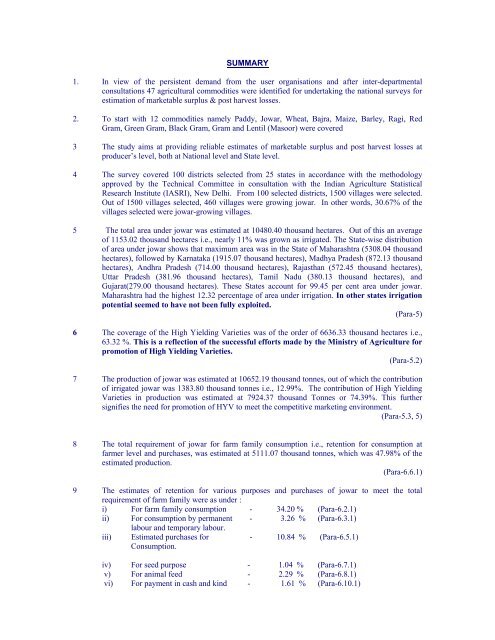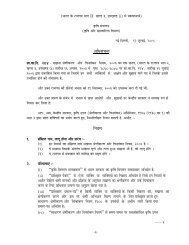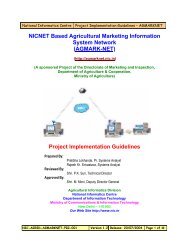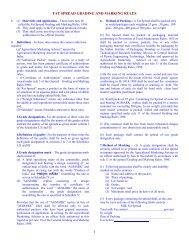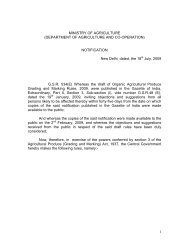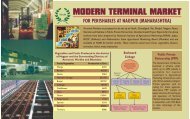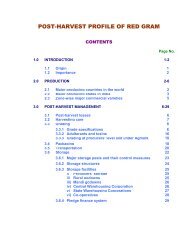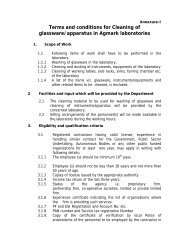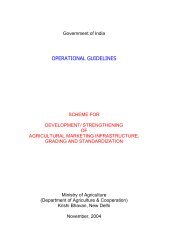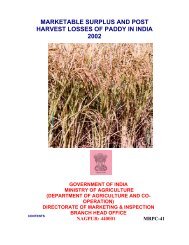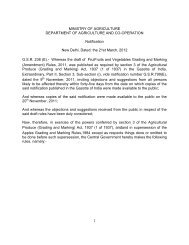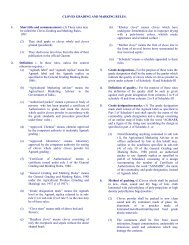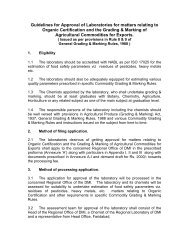Marketed Surplus and Post-harvest Losses of Jowar - Agmarknet
Marketed Surplus and Post-harvest Losses of Jowar - Agmarknet
Marketed Surplus and Post-harvest Losses of Jowar - Agmarknet
Create successful ePaper yourself
Turn your PDF publications into a flip-book with our unique Google optimized e-Paper software.
SUMMARY<br />
1. In view <strong>of</strong> the persistent dem<strong>and</strong> from the user organisations <strong>and</strong> after inter-departmental<br />
consultations 47 agricultural commodities were identified for undertaking the national surveys for<br />
estimation <strong>of</strong> marketable surplus & post <strong>harvest</strong> losses.<br />
2. To start with 12 commodities namely Paddy, <strong>Jowar</strong>, Wheat, Bajra, Maize, Barley, Ragi, Red<br />
Gram, Green Gram, Black Gram, Gram <strong>and</strong> Lentil (Masoor) were covered<br />
3 The study aims at providing reliable estimates <strong>of</strong> marketable surplus <strong>and</strong> post <strong>harvest</strong> losses at<br />
producer’s level, both at National level <strong>and</strong> State level.<br />
4 The survey covered 100 districts selected from 25 states in accordance with the methodology<br />
approved by the Technical Committee in consultation with the Indian Agriculture Statistical<br />
Research Institute (IASRI), New Delhi. From 100 selected districts, 1500 villages were selected.<br />
Out <strong>of</strong> 1500 villages selected, 460 villages were growing jowar. In other words, 30.67% <strong>of</strong> the<br />
villages selected were jowar-growing villages.<br />
5 The total area under jowar was estimated at 10480.40 thous<strong>and</strong> hectares. Out <strong>of</strong> this an average<br />
<strong>of</strong> 1153.02 thous<strong>and</strong> hectares i.e., nearly 11% was grown as irrigated. The State-wise distribution<br />
<strong>of</strong> area under jowar shows that maximum area was in the State <strong>of</strong> Maharashtra (5308.04 thous<strong>and</strong><br />
hectares), followed by Karnataka (1915.07 thous<strong>and</strong> hectares), Madhya Pradesh (872.13 thous<strong>and</strong><br />
hectares), Andhra Pradesh (714.00 thous<strong>and</strong> hectares), Rajasthan (572.45 thous<strong>and</strong> hectares),<br />
Uttar Pradesh (381.96 thous<strong>and</strong> hectares), Tamil Nadu (380.13 thous<strong>and</strong> hectares), <strong>and</strong><br />
Gujarat(279.00 thous<strong>and</strong> hectares). These States account for 99.45 per cent area under jowar.<br />
Maharashtra had the highest 12.32 percentage <strong>of</strong> area under irrigation. In other states irrigation<br />
potential seemed to have not been fully exploited.<br />
(Para-5)<br />
6 The coverage <strong>of</strong> the High Yielding Varieties was <strong>of</strong> the order <strong>of</strong> 6636.33 thous<strong>and</strong> hectares i.e.,<br />
63.32 %. This is a reflection <strong>of</strong> the successful efforts made by the Ministry <strong>of</strong> Agriculture for<br />
promotion <strong>of</strong> High Yielding Varieties.<br />
(Para-5.2)<br />
7 The production <strong>of</strong> jowar was estimated at 10652.19 thous<strong>and</strong> tonnes, out <strong>of</strong> which the contribution<br />
<strong>of</strong> irrigated jowar was 1383.80 thous<strong>and</strong> tonnes i.e., 12.99%. The contribution <strong>of</strong> High Yielding<br />
Varieties in production was estimated at 7924.37 thous<strong>and</strong> Tonnes or 74.39%. This further<br />
signifies the need for promotion <strong>of</strong> HYV to meet the competitive marketing environment.<br />
(Para-5.3, 5)<br />
8 The total requirement <strong>of</strong> jowar for farm family consumption i.e., retention for consumption at<br />
farmer level <strong>and</strong> purchases, was estimated at 5111.07 thous<strong>and</strong> tonnes, which was 47.98% <strong>of</strong> the<br />
estimated production.<br />
(Para-6.6.1)<br />
9 The estimates <strong>of</strong> retention for various purposes <strong>and</strong> purchases <strong>of</strong> jowar to meet the total<br />
requirement <strong>of</strong> farm family were as under :<br />
i) For farm family consumption - 34.20 % (Para-6.2.1)<br />
ii) For consumption by permanent - 3.26 % (Para-6.3.1)<br />
labour <strong>and</strong> temporary labour.<br />
iii) Estimated purchases for - 10.84 % (Para-6.5.1)<br />
Consumption.<br />
iv) For seed purpose - 1.04 % (Para-6.7.1)<br />
v) For animal feed - 2.29 % (Para-6.8.1)<br />
vi) For payment in cash <strong>and</strong> kind - 1.61 % (Para-6.10.1)


